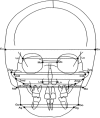Comparison between rapid and mixed maxillary expansion through an assessment of dento-skeletal effects on posteroanterior cephalometry
- PMID: 25139110
- PMCID: PMC4138550
- DOI: 10.1186/s40510-014-0046-9
Comparison between rapid and mixed maxillary expansion through an assessment of dento-skeletal effects on posteroanterior cephalometry
Abstract
Background: The aim of this study is to compare the dento-skeletal effects of rapid maxillary expansion (RME) and mixed maxillary expansion (MME), assessed on posteroanterior (PA) cephalograms.
Methods: Treatment groups consisted of 42 patients; mean age in RME group (n = 21,13 female and 8 male subjects) was 8.8 years ± 1.37 at T0 and 9.6 years ± 1.45 at T1 and mean age in MME group (n = 21, 12 female and 9 male patients) was 8.9 years ± 2.34 at T0 and 10.5 years ± 2.08 at T1. Seventeen bilateral anatomic landmarks, 16 linear (12 skeletal and 4 dental) and 4 angular measurements were assessed for each patient at T0 and T1. Data from the two groups were compared using independent sample t test (p < 0.05).
Results: At T0, the groups were similar for all examined variables (p > 0.05). Significant and equal increase of lateronasal and maxillary and upper and lower molar widths (p < 0. 01) occurred in both groups at T1. Significant but different increases were observed for maxillary incisal, upper left first molar-lateroorbitale, and maxillary first molar angles (p < 0.001 vs. p < 0.05). Significant increases were reported for upper inter-incisal width apex (p < 0.001) and upper right first molar-lateroorbitale angle (p < 0.05) only in the RME group. At T1, differences in maxillary incisal angle (p < 0.05), upper left first molar-lateroorbitale, and maxillary first molar angles (p < 0.001) were noted.
Conclusions: RME and MME were both effective to increase skeletal transverse dimensions by opening mid-palatal suture in growing patients, while MME was associated with minor dental side effects than RME.
Figures
Similar articles
-
Comparison between rapid and mixed maxillary expansion through an assessment of arch changes on dental casts.Prog Orthod. 2015;16:20. doi: 10.1186/s40510-015-0089-6. Epub 2015 Jun 27. Prog Orthod. 2015. PMID: 26122076 Free PMC article.
-
Dento-skeletal effects of mixed palatal expansion evaluated by postero-anterior cephalometric analysis.Eur J Paediatr Dent. 2014 Mar;15(1):59-62. Eur J Paediatr Dent. 2014. PMID: 24745595
-
Three-dimensional changes of the naso-maxillary complex following rapid maxillary expansion.Angle Orthod. 2014 Jan;84(1):88-95. doi: 10.2319/011313-36.1. Epub 2013 Jul 8. Angle Orthod. 2014. PMID: 23834270 Free PMC article.
-
Rapid maxillary expansion in the deciduous and mixed dentition evaluated through posteroanterior cephalometric analysis.Am J Orthod Dentofacial Orthop. 1995 Mar;107(3):268-75. doi: 10.1016/s0889-5406(95)70142-7. Am J Orthod Dentofacial Orthop. 1995. PMID: 7879759 Review.
-
Dento-skeletal effects produced by rapid versus slow maxillary expansion using fixed jackscrew expanders: a systematic review and meta-analysis.Eur J Orthod. 2021 Jun 8;43(3):301-312. doi: 10.1093/ejo/cjaa086. Eur J Orthod. 2021. PMID: 33950178
Cited by
-
Three-Dimensional Prospective Evaluation of Piezocision-Assisted and Conventional Rapid Maxillary Expansion: A Controlled Clinical Trial.Open Access Maced J Med Sci. 2019 Jan 5;7(1):127-133. doi: 10.3889/oamjms.2019.021. eCollection 2019 Jan 15. Open Access Maced J Med Sci. 2019. PMID: 30740176 Free PMC article.
-
Three-dimensional assessment on digital cast of spontaneous upper first molar distorotation after Ni-ti leaf springs expander and rapid maxillary expander: A two-centre randomized controlled trial.Orthod Craniofac Res. 2025 Feb;28(1):104-115. doi: 10.1111/ocr.12849. Epub 2024 Sep 8. Orthod Craniofac Res. 2025. PMID: 39244736 Free PMC article. Clinical Trial.
-
Comparison between rapid and mixed maxillary expansion through an assessment of arch changes on dental casts.Prog Orthod. 2015;16:20. doi: 10.1186/s40510-015-0089-6. Epub 2015 Jun 27. Prog Orthod. 2015. PMID: 26122076 Free PMC article.
-
Effect of non-surgical maxillary expansion on the nasal septum deviation: a systematic review.Prog Orthod. 2015;16:15. doi: 10.1186/s40510-015-0084-y. Epub 2015 Jun 4. Prog Orthod. 2015. PMID: 26061988 Free PMC article.
-
Anchorage onto deciduous teeth: effectiveness of early rapid maxillary expansion in increasing dental arch dimension and improving anterior crowding.Prog Orthod. 2015;16:22. doi: 10.1186/s40510-015-0093-x. Epub 2015 Jul 8. Prog Orthod. 2015. PMID: 26154156 Free PMC article.
References
-
- Lagravère MO, Major PW, Flores-Mir C. Long-term dental arch changes after rapid maxillary expansion treatment: a systematic review. Angle Orthod. 2005;75:155–161. - PubMed
Publication types
MeSH terms
LinkOut - more resources
Full Text Sources
Other Literature Sources
Miscellaneous



